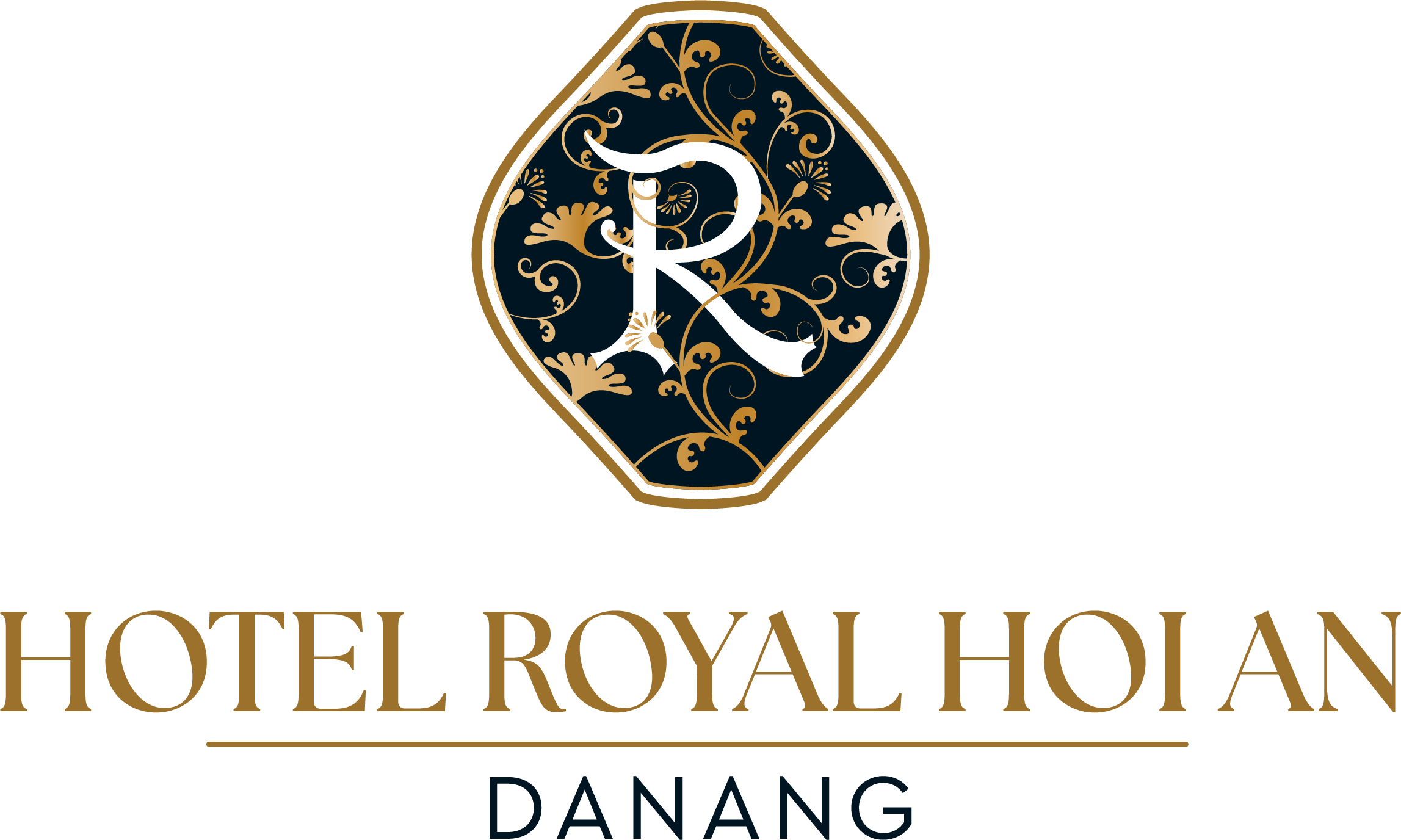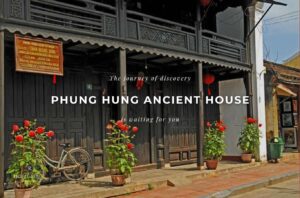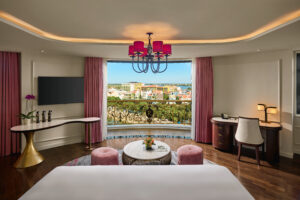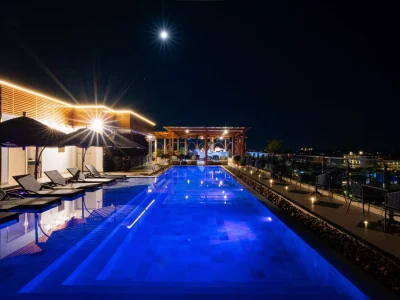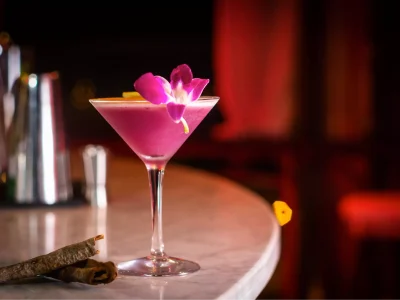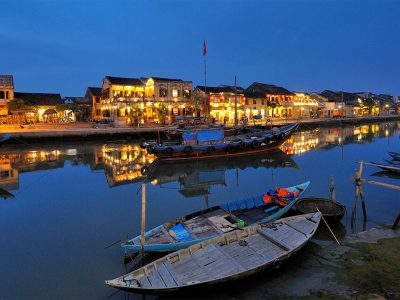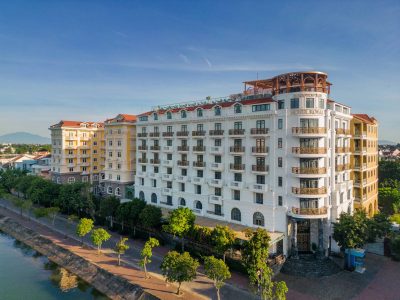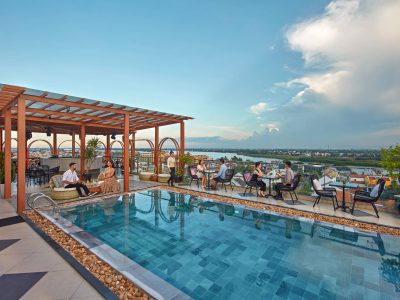In the heart of the peaceful ancient town, Hoi An offers an enchanting architectural space – where three cultures, Vietnamese, Japanese, and Chinese, blend harmoniously in every house and street corner. Each structure here is not only an aesthetic landmark but also a living testament to a prosperous era of trade. Let Hotel Royal Hoi An Gallery guide you through the unique beauty of this architecture, exploring every layer of time and the intricately carved details that reflect the essence of Eastern heritage.
Table of Contents
ToggleArchitectural styles through historical periods
Hoi An Ancient Town, located along the peaceful Thu Bon River, is one of the rare ancient cities in Southeast Asia that has preserved its traditional architecture almost intact. The architecture of Hoi An Ancient Town is a harmonious blend of Vietnamese, Chinese, Japanese, and Western influences. The wooden-frame houses with brick walls and curved tiled roofs are arranged in a traditional layout, clearly dividing spaces for business, daily living, and ancestral worship.
Each structure not only reflects the economic, cultural, and social development of its historical period but also contributes to forming a one-of-a-kind “living architectural museum” in Vietnam. Before diving into the detailed content, let’s take a look with Hotel Royal Hoi An Gallery at a comparison table of architectural structures through different periods:
| Criteria | Traditional Single-Story Houses (18th Century) | Two-Story Houses of the Commercial Era (1850–1888) | French Influenced Architecture (1888–1954) | East-West Fusion Architecture (1930 – Present) |
| Number of Floors | 1 floor | 2 floors (ground floor for business, upper floor for living) | 2 floors or more | 2 floors |
| Floor Plan | Three bays with two wings, internal courtyard | Ground floor extended for business | Symmetrical French-style structure | Improved townhouse floor plan |
| Roof Style | Yin-Yang roof with a steep slope | Yin-Yang roof, higher than the single-story house | French-style sloped roof | Yin-Yang roof combined with new materials |
| Main Materials | Lim wood, jackfruit wood, fired bricks, green stone | Wood, brick, wooden/iron railings | Load-bearing bricks, wood, iron-wrought balcony, bright-painted walls | Cement, iron, glass, ceramic tiles |
| Facade Details | Wide porch, large traditional wooden doors | Symmetrical, second-floor wooden blinds, small balcony | Iron balcony, large wooden doors, curved details | Large glass doors, iron railing, minimalist lines |
| External Architectural Influence | Purely Vietnamese, climate-adapted | Slight Western influence | French colonial style | Fusion of Eastern and Western styles |
| Representative Buildings | Duc An Ancient House | Shops along Tran Phu Street | Sa Huynh Culture Museum | Diep Dong Nguyen Ancient House |
| Primary Function | Family living | Business + living | Residential, administrative facilities | Living combined with business, modern aesthetics |
Traditional Single-Story House Architecture (18th Century)
The traditional single-story architecture in Hoi An during the 18th century was characterized by a one-story structure with a Yin-Yang tiled roof, wooden framing, and a layout in the form of a “three-bay, two-wing” design. This period marked the early development of the riverside town, as residents from Đại Việt (Vietnam) settled and developed small-scale production and trade activities.
These traditional houses were typically built close to the street, with a large front door, a wide porch, and an internal courtyard, promoting airflow in the tropical monsoon climate. The structure of the house was simple but sturdy, using traditional materials like lim wood, jackfruit wood, fired bricks, and green stone. The roof was usually low with a steep slope to ensure quick drainage during the rainy season.
If you visit Hoi An, you can visit the Duc An Ancient House on Tran Phu Street to admire this style of architecture from the 18th century.
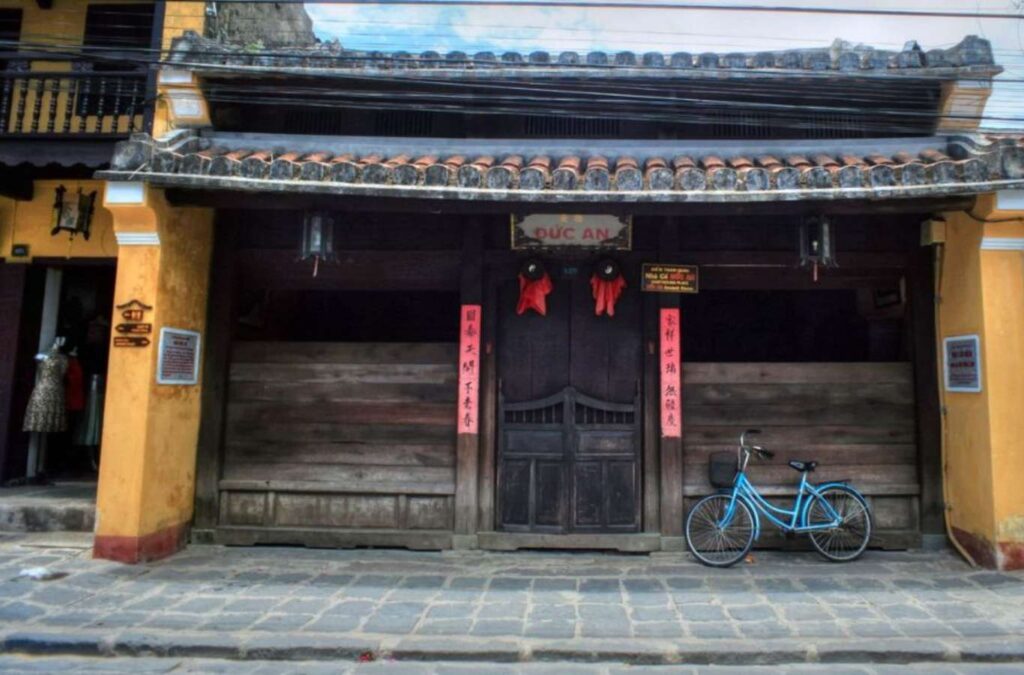
Two-Story House Architecture of the Commercial Era (1850–1888)
From 1850 to 1888, Hoi An entered a period of rapid commercial development, particularly as a trading hub of Central Vietnam. Two-story houses became common during this period as a solution to expand living space while also serving as places for business and storage.
In these two-story houses, the ground floor was used for business activities such as shops, stores, or reception areas, while the upper floor served as the living and working space for merchant families.
Architecturally, these two-story houses still retained traditional features like wooden frames, brick walls, and Yin-Yang tiled roofs but were taller and more grand than the single-story houses. The facades were typically designed symmetrically, with large wooden doors opening onto the street and wooden windows or louvered shutters on the second floor. Some houses even featured small balconies with wooden or iron railings, reflecting a slight Western architectural influence at the time.

Two-Story Architecture of the Commercial Era in Hoi An in the 1880s.
French-Inspired Architecture (1888–1954)
In 1888, when Central Vietnam became a protectorate under French Indochina, French colonial architecture began to influence urban areas in Vietnam, including Hoi An. Although the level of urbanization in Hoi An was not as high as in Hue or Da Nang, French architectural style left a clear mark on several civic, administrative, and merchant buildings.
Buildings from this period tended to use load-bearing brick walls, wooden doors, sloped tiled roofs, iron-wrought balconies, and brightly painted walls. Interestingly, many of the “colonial” style houses in Hoi An were built by wealthy Chinese merchants rather than being designed or constructed directly by the French.
A typical example of this style is the Sa Huynh Culture Museum, located on Tran Phu Street.
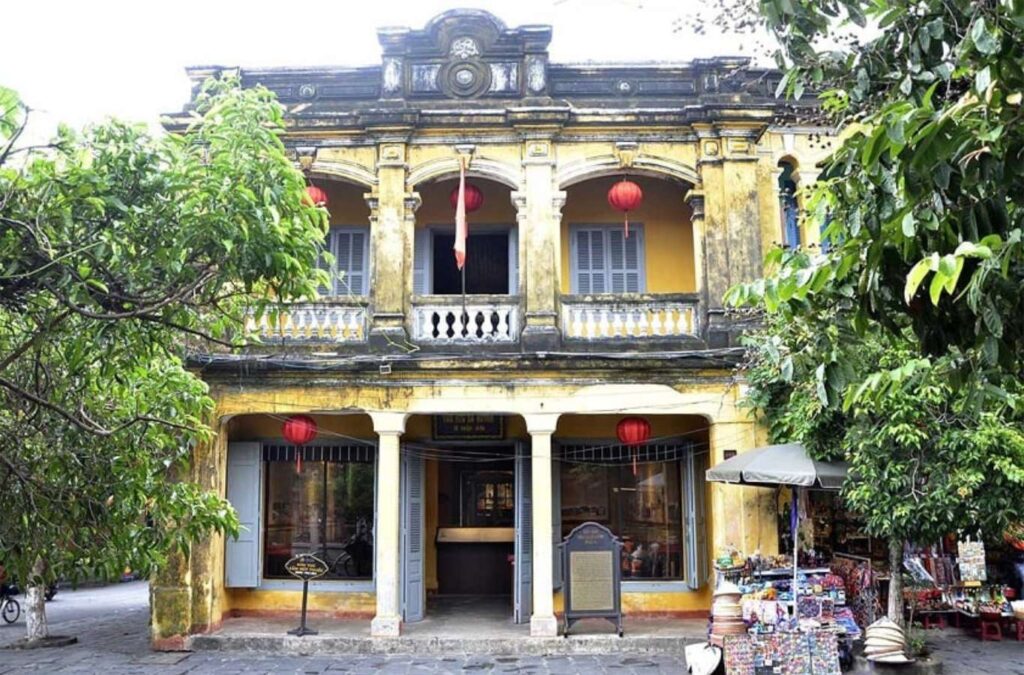
East-West Fusion Architecture (1930 to Present)
From the 1930s onwards, the architecture of Hoi An Ancient Town began to show a fusion between traditional Eastern elements and modern Western influences. This change reflected the new lifestyle needs and changing aesthetic preferences of the merchant families and the emerging middle class in the ancient town.
Typical buildings still maintained the two-story townhouse layout, with traditional wooden frames, Yin-Yang tiled roofs, but the facades were updated with large glass windows, iron railings, and minimalist architectural details. New materials such as cement, ceramic tiles, glass, and iron became more widely used. A prime example of this style is the Diệp Đồng Nguyên Ancient House – a building with a modern exterior but a traditional interior layout with three bays and a space for ancestral worship.
Read more:
- What is the best season to visit Hoi An? Let’s explore it
- 30+ Hoi An tourist destinations that you should not miss
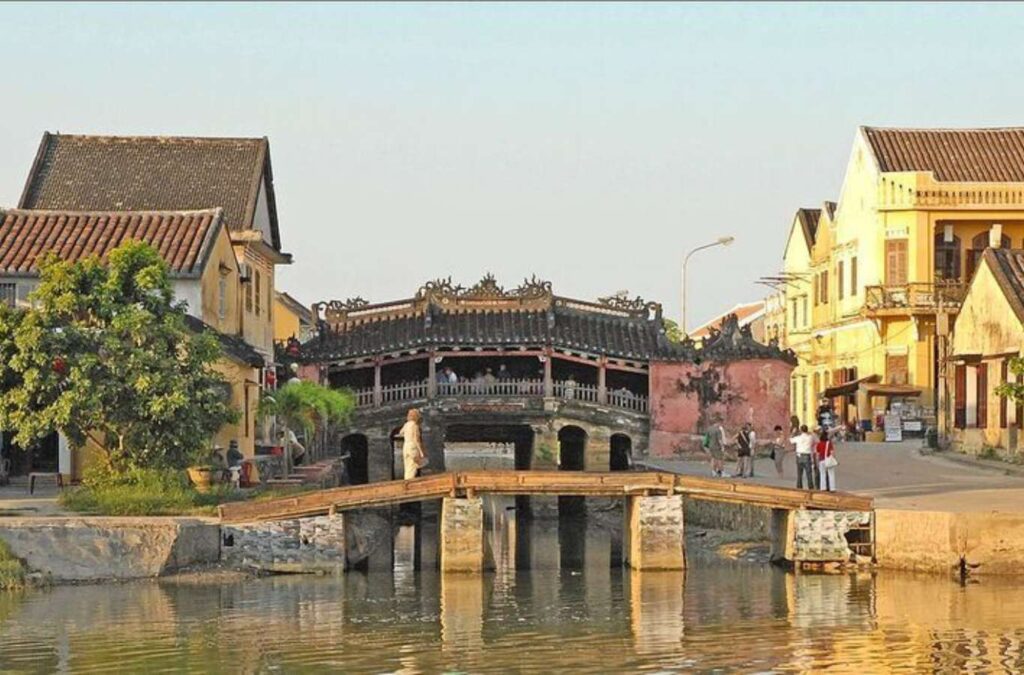
Distinctive features of Hoi An ancient town architecture
The houses in Hoi An’s ancient town serve as both residences and a reflection of the distinct merchant lifestyle of its inhabitants. The architecture and spatial organization clearly demonstrate adaptation to the climate and the needs of business activities intertwined with family life. Here are some of the unique architectural features you can truly experience when you visit this land
Ancient Townhouses
The ancient townhouses are a distinctive architectural form that has helped shape the appearance of Hoi An’s urban landscape. These houses are typically built in the style of two-story townhouses with narrow facades and deep interiors, forming continuous rows along narrow streets such as Tran Phu, Nguyen Thai Hoc, and Bach Dang.
In terms of structural design, the ancient townhouses often use lim wood frames, fired brick walls, and Yin-Yang tiled roofs – a design that is not only durable but also well-suited to the humid, rainy climate of Central Vietnam. The interior space is divided into three distinct functional areas:
- The front area for business activities.
- The middle area for family living.
- The back area for ancestor worship or a courtyard to promote airflow.
Although the external appearance of these townhouses is simple, interior details like wooden doors, porches, ornamental beams, and decorative carvings are meticulously crafted, reflecting the essence of East Asian culture.

Architecture of historical monuments
The historical monuments in Hoi An Ancient Town include assembly halls, clan houses, temples, and shrines, reflecting the clear cultural convergence of Vietnamese, Chinese, and Japanese influences. Each building has its own unique architectural style.
| Monument Type | Example | Architectural Style | Purpose | Notable Features |
| Chinese Assembly Halls | Phuc Kien, Quang Dong, Chieu Chau Halls | Classical Chinese: three gates, curved roof eaves | Community activities, worship | Dragon and phoenix decorations, ceramic reliefs, deity statues |
| Vietnamese Clan Houses | Tran Clan House, Nguyen Clan House | Traditional Vietnamese, rustic | Ancestor worship, family heritage | Large courtyard, walls, solemn main worship hall |
| Vietnamese Temples & Shrines | Ong Pagoda, Quan Cong Temple | Folk-style, simple materials | Buddhist and folk beliefs | Tiled roof, wooden columns, small sacred spaces |
Although these buildings were constructed centuries ago, most have retained their original value after several restorations, contributing to the distinct cultural identity of Hoi An Ancient Town.
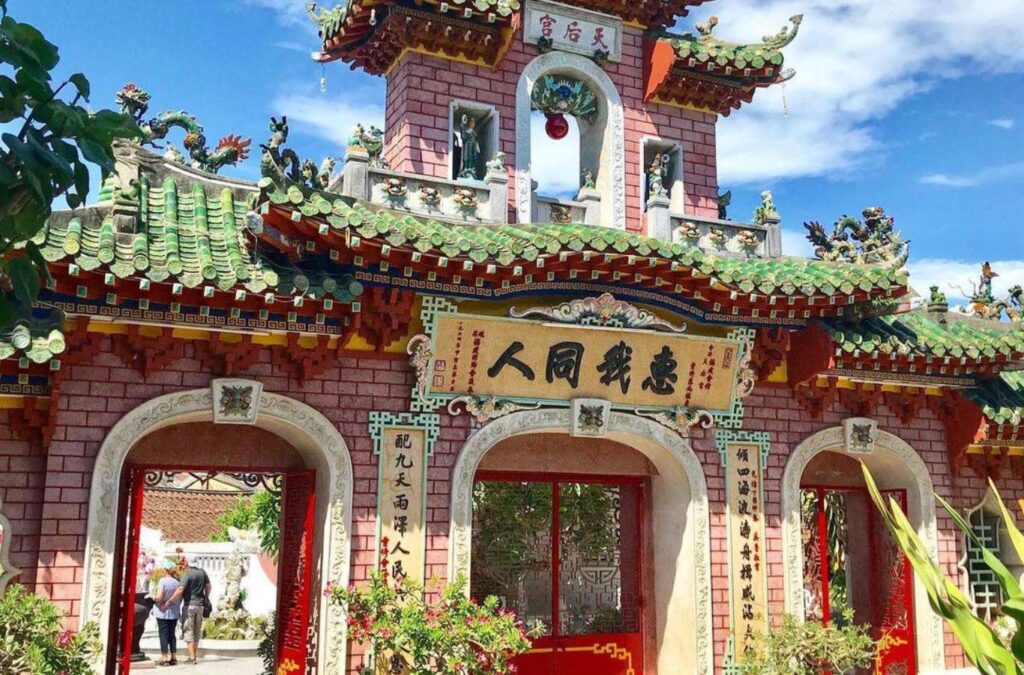
Street Architecture
Hoi An Ancient Town is planned in a classic checkerboard pattern, with short, narrow streets intersecting at right angles, creating an urban structure that is both functional and pedestrian-friendly. This layout allows for a clear separation between residential, commercial, and communal spaces, while also facilitating flexible and accessible internal traffic.
Main streets like Tran Phu, Nguyen Thai Hoc, and Bach Dang run parallel to the Thu Bon River, paved with traditional stone slabs or tamped earth, offering a rustic yet durable beauty. On both sides of these streets are rows of traditional townhouses, with facades facing the street, creating an open space that is ideal for commercial trade that has existed for centuries.
Read more: [2025] Nightlife in Hoi An: Top 11 experiences to explore

Iconic Architectural Works
Within the heart of Hoi An Ancient Town, many heritage buildings have retained their aesthetic and historical value, becoming cultural symbols that are essential to the visitor experience.
- Chua Cau (Japanese Bridge): According to the legend of Tran Cu, the bridge was built in the 17th century and is a unique structure in Vietnam that combines Japanese architecture with traditional wooden bridge-building techniques. The most notable feature is the shrine located on the bridge itself, with its Yin-Yang tiled roof, creating a perfect blend of transportation function and spiritual
- Phuc Kien Assembly Hall: Representing the prosperity of the Chinese community in Hoi An, this hall is laid out in a “three-part” design, with several overlapping spaces. The main hall is adorned with colorful carvings, incense burners, lanterns, and deity statues, reflecting the community’s spiritual beliefs and power.
- Tan Ky Ancient House: A model of 19th-century Hoi An merchant houses, where Vietnamese, Chinese, and Japanese architecture converge. The house features a front sales area, a central living space, and a rear section for ancestor worship. The house has been preserved for seven generations.
- Tran Clan House: This heritage site embodies the distinctive architectural style of Hoi An’s ancient town and the Vietnamese tradition of ancestral worship. The complex features a spacious courtyard and a solemn main hall, serving as a place to preserve genealogies, worship artifacts, and the enduring values of family heritage.
- Phung Hung Ancient House: Built in the 19th century, this over-100-year-old residence once belonged to a wealthy merchant who named it “Phung Hung”, symbolizing his wish for prosperity in business. The house showcases a harmonious blend of Vietnamese, Chinese, and Japanese architectural styles, distinguished by its high wooden loft, spacious corridors, and distinctive East Asian charm.
Each of these buildings is not just an architectural landmark but also a living piece of history, reflecting the development of Hoi An Ancient Town and the cultural exchange of East Asian civilizations.

Hotel Royal Hoi An Gallery – A 5 Star Resort with Unique Architecture
If you’re looking for a place to stay in Hoi An, Hotel Royal Hoi An Gallery is an unmissable choice. With its refined design inspired by the historical love story between Sotaro Araki and Princess Ngoc Hoa, the hotel not only offers luxurious accommodation but also provides guests with a unique experience of Vietnamese-Japanese culture.
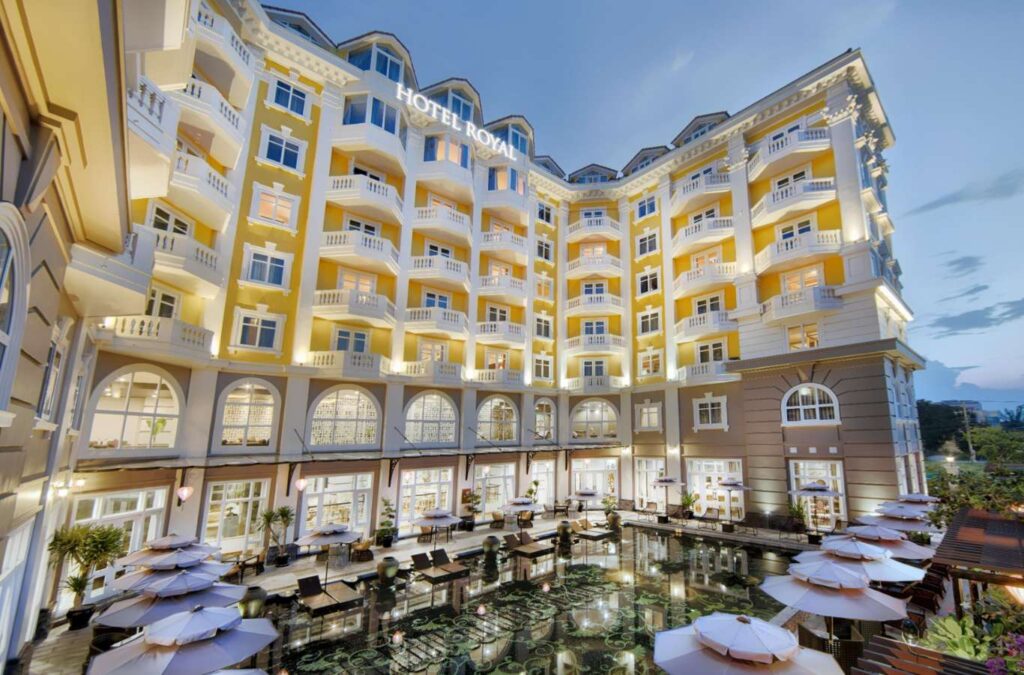
Indulge in the most luxurious accommodation, the Presidential Suite. This exceptional retreat spans an impressive 70 sqm and offers guests a world of bespoke services, unparalleled comfort, stunning views, and indulgent amenities.
- 70sqm (753sq ft)
- 2 Adults
The hotel has a total of 187 rooms and suites, each decorated opulently. In addition, Hotel Royal Hoi An Gallery offers other top-tier services and amenities to cater to your stay:
- Wakaku (Japanese Restaurant): Exceptional value for money with 5-star quality dishes.
- Faifo Café: An all-day dining restaurant serving international and Vietnamese dishes, with a unique open-kitchen concept.
- The Deck: The highest rooftop bar in Hoi An, where you can enjoy cocktails and panoramic views of the city from above.
- River Bar: A relaxing poolside bar offering unique cocktails and local drinks.
- The Attic Bar: An ideal place to enjoy premium drinks with breathtaking views of the ancient town and the scenic river.
- Woosah Spa: A sanctuary for relaxation, offering therapeutic treatments to restore energy and health.
- Executive Lounge: A luxurious space exclusively for guests staying in Royal Deluxe, Deluxe Suite, or 2-Bedroom Suites. Located on the 8th floor of the Wakaku wing, the Executive Lounge offers stunning views of the Thu Bon River and Hoi An, providing a perfect place to unwind or work.
The hotel also organizes unique cultural experiences like Vietnamese coffee-making classes, calligraphy, fan painting, lantern-making, and artistic mask painting. These activities give you the chance to deeply explore and appreciate the local culture in a memorable way.
We hope this article has helped you understand the unique architectural beauty of Hoi An Ancient Town. With these insights, Hotel Royal Hoi An Gallery hopes to inspire you to explore and experience the wonderful cultural heritage that Hoi An has to offer.
Read more:
